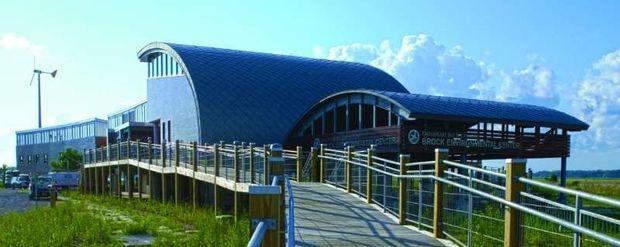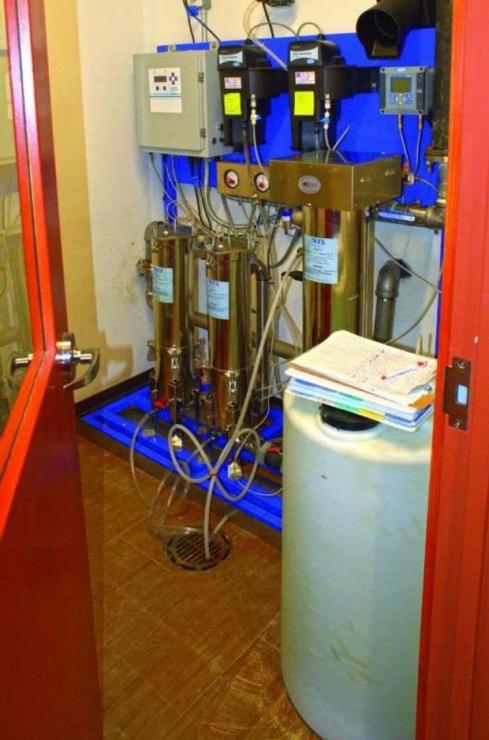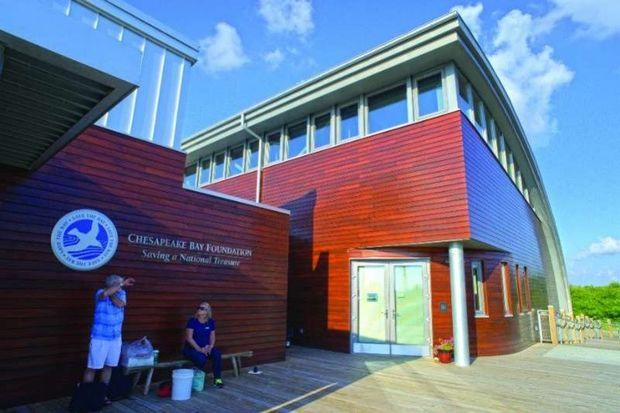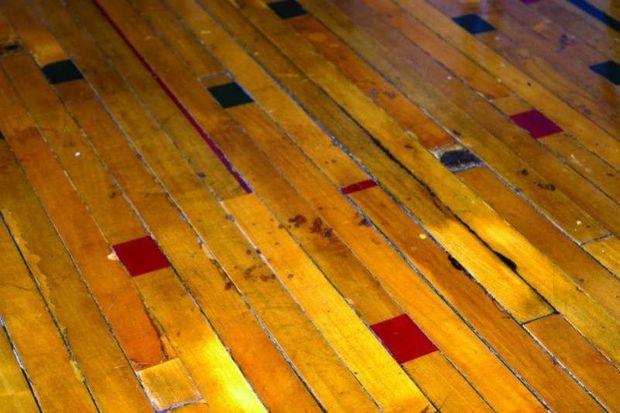
If you want to see an office building from the future, you need to visit the Brock Environmental Center in Virginia Beach, VA. As soon as you see it, you know it’s different. It is not some squarish shape, but curves along the waterfront. Two attention-getting wind turbines spin overhead. One side has few windows; the opposite side many. This is not your dad’s office building!
The Brock Center is not just futuristic; it is ultra-green. In July 2015, the building received the highest designation a green building can earn, LEED Platinum. LEED stands for Leadership in Energy and Environmental Design. The building earned this designation because it generates its own electricity and uses geothermal and solar heat. Purified rain water rinses your hands. There is no runoff. The Brock Center is designed to be totally self-sufficient.

This environmental wonder houses operations for the Chesapeake Bay Foundation (CBF) in southeast Virginia. It is also home to the Lynnhaven River NOW organization. It is named after philanthropists Joan and Macon Brock. Located on Pleasure House Point by the mouth of the Lynnhaven River, it is the only building on a 118-acre site that was originally slated for development. The site was saved from concrete when the housing market took a nose dive in 2009. The bank ended up owning the property. A concentrated effort to save the site resulted in a partnership between the City of Virginia Beach, the bank, CBF, Lynnhaven River NOW, the Brocks, and the Hampton Roads community.
Community and donor support played a tremendous role in this environmental success. The result is a city park open to the public for hiking, bird watching, and other outdoor activities and the Brock Environmental Center.
The building is curved to take advantage of the sun and breezes. The design allows for solar gain in the winter, but blocks the heat in the summer. On the inside, you will notice beautiful wood floors. These are recycled from a high school in Norfolk. According to Chris Gorri, the building manager, most of the wood inside the center is recycled. “We used a gym floor, old wood bleachers, and even old oak fence posts,” he says.

The unique ceiling fans literally move all the air in a room. You don’t have to stand under the fan to feel the air circulating. Building materials do not contain any undesirable chemicals. The builder had a 20-chemical list to watch. All materials used in construction had to be free of these chemicals, such as asbestos, formaldehyde, lead, and PVC. These chemicals are common in traditional building products. The windows allow plenty of light, reducing the need for light bulbs. Some windows open and close automatically in order to reduce the need for artificial heat or air conditioning. The water that comes out of the bathroom faucet is treated rain water. The Brock Center is the first commercial building in the United States to collect and treat rain water for human consumption.

The building is well suited for the offices of the two environmental groups. Every day, it is heated or cooled without consuming energy from the outside. Even the waste stays on site, minimizing environmental impact.
A computer runs all of this technology day and night. It opens and closes windows, monitors temperature in rooms, adjusts lighting, heat, and air conditioning. While the Brock Center stores rain water for future use, it does not store any extra electricity. When the building generates more electricity than it uses, it sends the extra back to the grid. The electric meter runs backward!
And it all works. The Brock Center is not just a success at being green, it is a success for those who learn and work there. The practical, comfortable building is a must-see if you are interested in green building design. CBF offers tours of the building. Check the schedule at
CBF.org or by calling (757) 622-1964 ext. 3312.
by Kendall Osborne If you want to see an office building from the future, you need to visit the Brock Environmental Center in Virginia Beach, VA. As soon as you see it, you know it’s different. It is not some squarish shape, but curves along the waterfront. Two attention-getting wind turbines spin overhead. One side has few windows; the opposite side many. This is not your dad’s office building!
The Brock Center is not just futuristic; it is ultra-green. In July 2015, the building received the highest designation a green building can earn, LEED Platinum. LEED stands for Leadership in Energy and Environmental Design. The building earned this designation because it generates its own electricity and uses geothermal and solar heat. Purified rain water rinses your hands. There is no runoff. The Brock Center is designed to be totally self-sufficient.
If you want to see an office building from the future, you need to visit the Brock Environmental Center in Virginia Beach, VA. As soon as you see it, you know it’s different. It is not some squarish shape, but curves along the waterfront. Two attention-getting wind turbines spin overhead. One side has few windows; the opposite side many. This is not your dad’s office building!
The Brock Center is not just futuristic; it is ultra-green. In July 2015, the building received the highest designation a green building can earn, LEED Platinum. LEED stands for Leadership in Energy and Environmental Design. The building earned this designation because it generates its own electricity and uses geothermal and solar heat. Purified rain water rinses your hands. There is no runoff. The Brock Center is designed to be totally self-sufficient.
 This environmental wonder houses operations for the Chesapeake Bay Foundation (CBF) in southeast Virginia. It is also home to the Lynnhaven River NOW organization. It is named after philanthropists Joan and Macon Brock. Located on Pleasure House Point by the mouth of the Lynnhaven River, it is the only building on a 118-acre site that was originally slated for development. The site was saved from concrete when the housing market took a nose dive in 2009. The bank ended up owning the property. A concentrated effort to save the site resulted in a partnership between the City of Virginia Beach, the bank, CBF, Lynnhaven River NOW, the Brocks, and the Hampton Roads community.
Community and donor support played a tremendous role in this environmental success. The result is a city park open to the public for hiking, bird watching, and other outdoor activities and the Brock Environmental Center.
The building is curved to take advantage of the sun and breezes. The design allows for solar gain in the winter, but blocks the heat in the summer. On the inside, you will notice beautiful wood floors. These are recycled from a high school in Norfolk. According to Chris Gorri, the building manager, most of the wood inside the center is recycled. “We used a gym floor, old wood bleachers, and even old oak fence posts,” he says.
This environmental wonder houses operations for the Chesapeake Bay Foundation (CBF) in southeast Virginia. It is also home to the Lynnhaven River NOW organization. It is named after philanthropists Joan and Macon Brock. Located on Pleasure House Point by the mouth of the Lynnhaven River, it is the only building on a 118-acre site that was originally slated for development. The site was saved from concrete when the housing market took a nose dive in 2009. The bank ended up owning the property. A concentrated effort to save the site resulted in a partnership between the City of Virginia Beach, the bank, CBF, Lynnhaven River NOW, the Brocks, and the Hampton Roads community.
Community and donor support played a tremendous role in this environmental success. The result is a city park open to the public for hiking, bird watching, and other outdoor activities and the Brock Environmental Center.
The building is curved to take advantage of the sun and breezes. The design allows for solar gain in the winter, but blocks the heat in the summer. On the inside, you will notice beautiful wood floors. These are recycled from a high school in Norfolk. According to Chris Gorri, the building manager, most of the wood inside the center is recycled. “We used a gym floor, old wood bleachers, and even old oak fence posts,” he says.
 The unique ceiling fans literally move all the air in a room. You don’t have to stand under the fan to feel the air circulating. Building materials do not contain any undesirable chemicals. The builder had a 20-chemical list to watch. All materials used in construction had to be free of these chemicals, such as asbestos, formaldehyde, lead, and PVC. These chemicals are common in traditional building products. The windows allow plenty of light, reducing the need for light bulbs. Some windows open and close automatically in order to reduce the need for artificial heat or air conditioning. The water that comes out of the bathroom faucet is treated rain water. The Brock Center is the first commercial building in the United States to collect and treat rain water for human consumption.
The unique ceiling fans literally move all the air in a room. You don’t have to stand under the fan to feel the air circulating. Building materials do not contain any undesirable chemicals. The builder had a 20-chemical list to watch. All materials used in construction had to be free of these chemicals, such as asbestos, formaldehyde, lead, and PVC. These chemicals are common in traditional building products. The windows allow plenty of light, reducing the need for light bulbs. Some windows open and close automatically in order to reduce the need for artificial heat or air conditioning. The water that comes out of the bathroom faucet is treated rain water. The Brock Center is the first commercial building in the United States to collect and treat rain water for human consumption.
 The building is well suited for the offices of the two environmental groups. Every day, it is heated or cooled without consuming energy from the outside. Even the waste stays on site, minimizing environmental impact.
A computer runs all of this technology day and night. It opens and closes windows, monitors temperature in rooms, adjusts lighting, heat, and air conditioning. While the Brock Center stores rain water for future use, it does not store any extra electricity. When the building generates more electricity than it uses, it sends the extra back to the grid. The electric meter runs backward!
And it all works. The Brock Center is not just a success at being green, it is a success for those who learn and work there. The practical, comfortable building is a must-see if you are interested in green building design. CBF offers tours of the building. Check the schedule at CBF.org or by calling (757) 622-1964 ext. 3312.
by Kendall Osborne
The building is well suited for the offices of the two environmental groups. Every day, it is heated or cooled without consuming energy from the outside. Even the waste stays on site, minimizing environmental impact.
A computer runs all of this technology day and night. It opens and closes windows, monitors temperature in rooms, adjusts lighting, heat, and air conditioning. While the Brock Center stores rain water for future use, it does not store any extra electricity. When the building generates more electricity than it uses, it sends the extra back to the grid. The electric meter runs backward!
And it all works. The Brock Center is not just a success at being green, it is a success for those who learn and work there. The practical, comfortable building is a must-see if you are interested in green building design. CBF offers tours of the building. Check the schedule at CBF.org or by calling (757) 622-1964 ext. 3312.
by Kendall Osborne